Formation of Dislocations and Stacking Faults in Embedded Individual Grains during In Situ Tensile Loading of an Austenitic Stainless Steel
Abstract
:1. Introduction
2. Materials and Methods
3. Results and Discussion
4. Conclusions
Author Contributions
Funding
Institutional Review Board Statement
Informed Consent Statement
Data Availability Statement
Acknowledgments
Conflicts of Interest
References
- Lo, K.H.; Shek, C.H.; Lai, J.K.L. Recent developments in stainless steels. Mater. Sci. Eng. R Rep. 2009, 65, 39–104. [Google Scholar] [CrossRef]
- De Bellefon, G.M.; Van Duysen, J.C. Tailoring plasticity of austenitic stainless steels for nuclear applications: Review of mechanisms controlling plasticity of austenitic steels below 400 °C. J. Nucl. Mater. 2016, 475, 168–191. [Google Scholar] [CrossRef] [Green Version]
- Tian, Y.; Gorbatov, O.I.; Borgenstam, A.; Ruban, A.V.; Hedström, P. Deformation Microstructure and Deformation-Induced Martensite in Austenitic Fe-Cr-Ni Alloys Depending on Stacking Fault Energy. Metall. Mater. Trans. A Phys. Metall. Mater. Sci. 2017, 48, 1–7. [Google Scholar] [CrossRef] [Green Version]
- Hedström, P.; Lienert, U.; Almer, J.; Odén, M. Stepwise transformation behavior of the strain-induced martensitic transformation in a metastable stainless steel. Scr. Mater. 2007, 56, 213–216. [Google Scholar] [CrossRef]
- Olson, G.B.; Cohen, M. A general mechanism of martensitic nucleation: Part I. General concepts and the FCC → HCP transformation. Metall. Trans. A 1976, 7, 1897–1904. [Google Scholar] [CrossRef]
- Das, A. Revisiting Stacking Fault Energy of Steels. Metall. Mater. Trans. A Phys. Metall. Mater. Sci. 2016, 47, 748–768. [Google Scholar] [CrossRef]
- Neding, B.; Gorbatov, O.I.; Tseng, J.-C.; Hedström, P. In situ bulk observations and ab initio calculations revealing the temperature dependence of stacking fault energy in Fe-Cr-Ni alloys. Metall. Mater. Trans. A 2021, in press. [Google Scholar]
- Goodchild, D.; Roberts, W.T.; Wilson, D.V. Plastic deformation and phase transformation in textured austenitic stainless steel. Acta Metall. 1970, 18, 1137–1145. [Google Scholar] [CrossRef]
- Kireeva, I.V.; Chumlyakov, Y.I. Orientation dependence of the γ-α’ martensitic transformation in single crystals of austenitic stainless steels with low stacking-fault energy. Phys. Met. Metallogr. 2007, 103, 88–104. [Google Scholar] [CrossRef]
- Hedström, P.; Lienert, U.; Almer, J.; Odén, M. Elastic strain evolution and ε-martensite formation in individual austenite grains during in situ loading of a metastable stainless steel. Mater. Lett. 2008, 62, 338–340. [Google Scholar] [CrossRef]
- Williams, D.B.; Carter, C.B.; Williams, D.B.; Carter, C.B. Transmission Electron Microscopy; Springer: New York, NY, USA, 1996; ISBN 9780387765006. [Google Scholar]
- Poulsen, H.F. Three-Dimensional X-ray Diffraction Microscopy, 1st ed.; Springer: Berlin/Heidelberg, Germany, 2004. [Google Scholar]
- Hedström, P. Deformation and Martensitic Phase Transformation in Stainless Steels. Ph.D. Thesis, Luleå University of Technology, Luleå, Sweden, 2007. [Google Scholar]
- Pantleon, W.; Poulsen, H.F.; Almer, J.; Lienert, U. In situ X-ray peak shape analysis of embedded individual grains during plastic deformation of metals. Mater. Sci. Eng. A 2004, 387–389, 339–342. [Google Scholar] [CrossRef]
- Shade, P.A.; Blank, B.; Schuren, J.C.; Turner, T.J.; Kenesei, P.; Goetze, K.; Suter, R.M.; Bernier, J.V.; Li, S.F.; Lind, J.; et al. A rotational and axial motion system load frame insert for in situ high energy x-ray studies. Rev. Sci. Instrum. 2015, 86. [Google Scholar] [CrossRef] [Green Version]
- Bernier, J.V.; Barton, N.R.; Lienert, U.; Miller, M.P. Far-field high-energy diffraction microscopy: A tool for intergranular orientation and strain analysis. J. Strain Anal. Eng. Des. 2011, 46, 527–547. [Google Scholar] [CrossRef]
- Nygren, K.E.; Pagan, D.C.; Bernier, J.V.; Miller, M.P. An algorithm for resolving intragranular orientation fields using coupled far-field and near-field high energy X-ray diffraction microscopy. Mater. Charact. 2020, 165, 110366. [Google Scholar] [CrossRef]
- Simm, T.H. Peak broadening anisotropy and the contrast factor in metal alloys. Crystals 2018, 8, 212. [Google Scholar] [CrossRef] [Green Version]
- Balogh, L.; Ribárik, G.; Ungár, T. Stacking faults and twin boundaries in fcc crystals determined by x-ray diffraction profile analysis. J. Appl. Phys. 2006, 100. [Google Scholar] [CrossRef]
- Ungár, T.; Dragomir, I.; Révész, Á.; Borbély, A. The contrast factors of dislocations in cubic crystals: The dislocation model of strain anisotropy in practice. J. Appl. Crystallogr. 1999, 32, 992–1002. [Google Scholar] [CrossRef] [Green Version]
- Scardi, P.; Leoni, M.; Delhez, R. Line broadening analysis using integral breadth methods: A critical review. J. Appl. Crystallogr. 2004, 37, 381–390. [Google Scholar] [CrossRef]
- Kerber, M.B.; Zehetbauer, M.J.; Schafler, E.; Spieckermann, F.C.; Bernstorff, S.; Ungar, T. X-ray line profile analysis-An ideal tool to quantify structural parameters of nanomaterials. JOM 2011, 63, 61–70. [Google Scholar] [CrossRef]
- Warren, B.E. X-ray Diffraction; Dover Publications, Inc.: New York, NJ, USA, 1990. [Google Scholar]
- Velterop, L.; Delhez, R.; De Keijser, T.H.; Mittemeijer, E.J.; Reefman, D. X-ray diffraction analysis of stacking and twin faults in f.c.c. metals: A revision and allowance for texture and non-uniform fault probabilities. J. Appl. Crystallogr. 2000, 33, 296–306. [Google Scholar] [CrossRef]
- Ungár, T.; Borbély, A. The effect of dislocation contrast on x-ray line broadening: A new approach to line profile analysis. Appl. Phys. Lett. 1996, 69, 3173–3175. [Google Scholar] [CrossRef]
- Neding, B.; Tian, Y.; Ko, P.; Hedström, P. Correlating temperature-dependent stacking fault energy and in-situ bulk deformation behavior for a metastable austenitic stainless steel. Unpublished.
- Rafaja, D.; Krbetschek, C.; Ullrich, C.; Martin, S. Stacking fault energy in austenitic steels determined by using in situ X-ray diffraction during bending. J. Appl. Crystallogr. 2014, 47, 936–947. [Google Scholar] [CrossRef]
- Ullrich, C.; Eckner, R.; Krüger, L.; Martin, S.; Klemm, V.; Rafaja, D. Interplay of microstructure defects in austenitic steel with medium stacking fault energy. Mater. Sci. Eng. A 2016, 649, 390–399. [Google Scholar] [CrossRef]
- Ullrich, C.; Martin, S.; Schimpf, C.; Stark, A.; Schell, N.; Rafaja, D. Deformation Mechanisms in Metastable Austenitic TRIP/TWIP Steels under Compressive Load Studied by in situ Synchrotron Radiation Diffraction. Adv. Eng. Mater. 2019, 21, 1–9. [Google Scholar] [CrossRef] [Green Version]
- Byun, T.S. On the stress dependence of partial dislocation separation and deformation microstructure in austenitic stainless steels. Acta Mater. 2003, 51, 3063–3071. [Google Scholar] [CrossRef]
- Karaman, I.; Yapici, G.G.; Chumlyakov, Y.I.; Kireeva, I.V. Deformation twinning in difficult-to-work alloys during severe plastic deformation. Mater. Sci. Eng. A 2005, 410–411, 243–247. [Google Scholar] [CrossRef]
- Mainprice, D.; Hielscher, R.; Schaeben, H. Calculating anisotropic physical properties from texture data using the MTEX open-source package. Geol. Soc. Spec. Publ. 2011, 360, 175–192. [Google Scholar] [CrossRef] [Green Version]
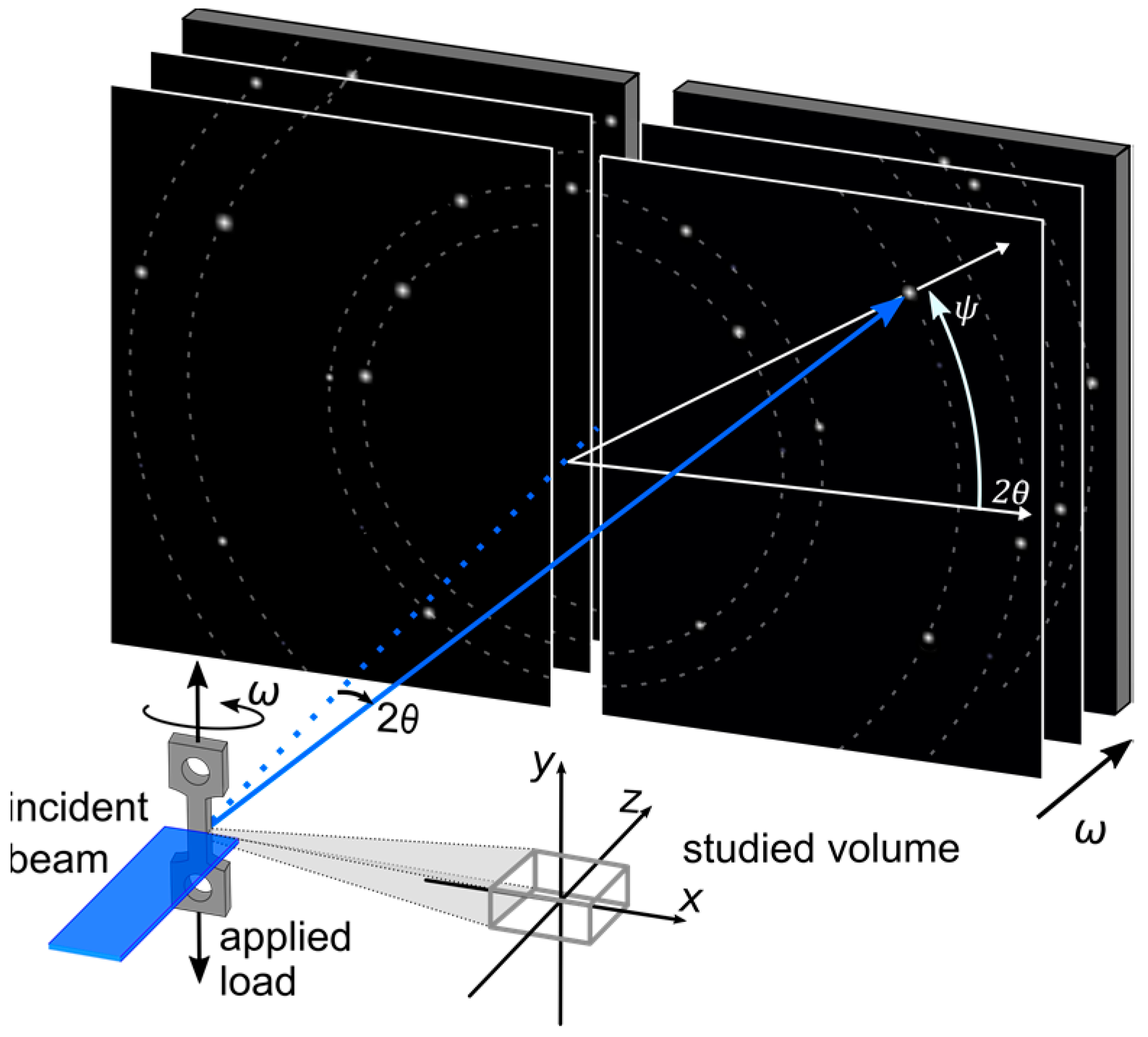
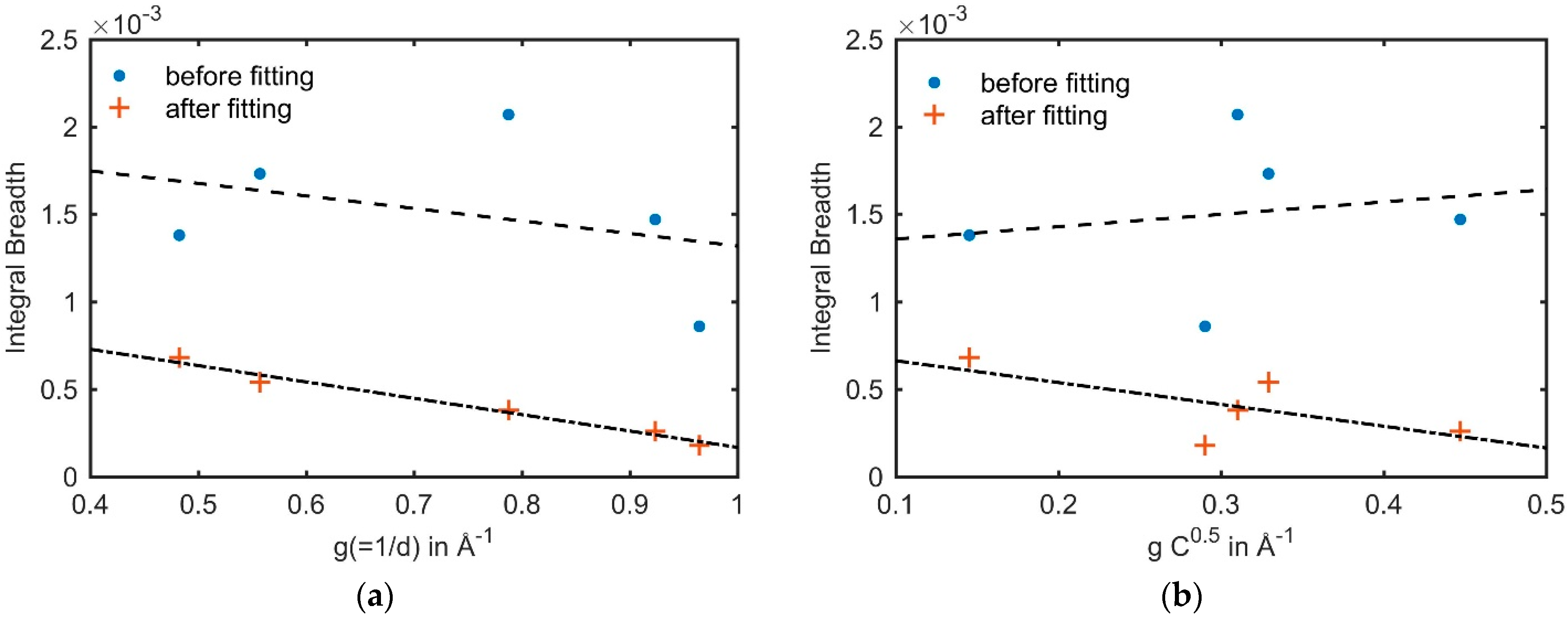
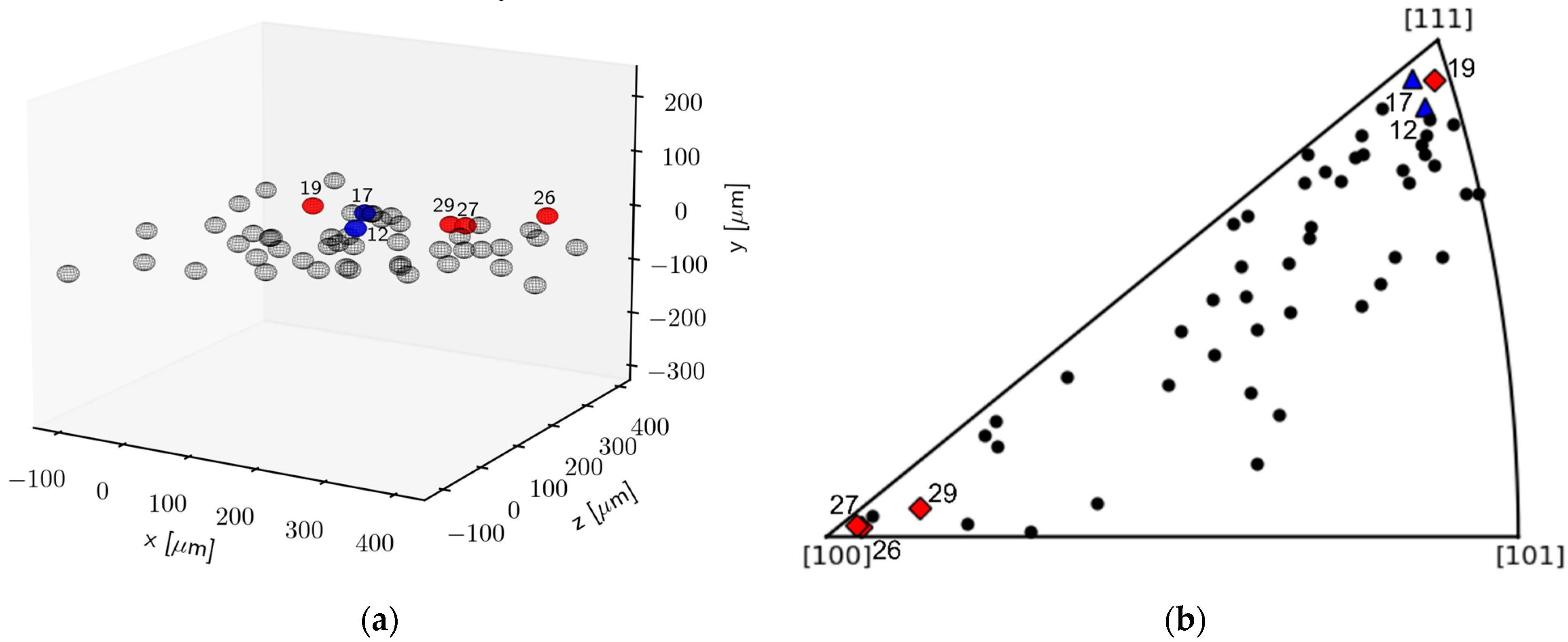
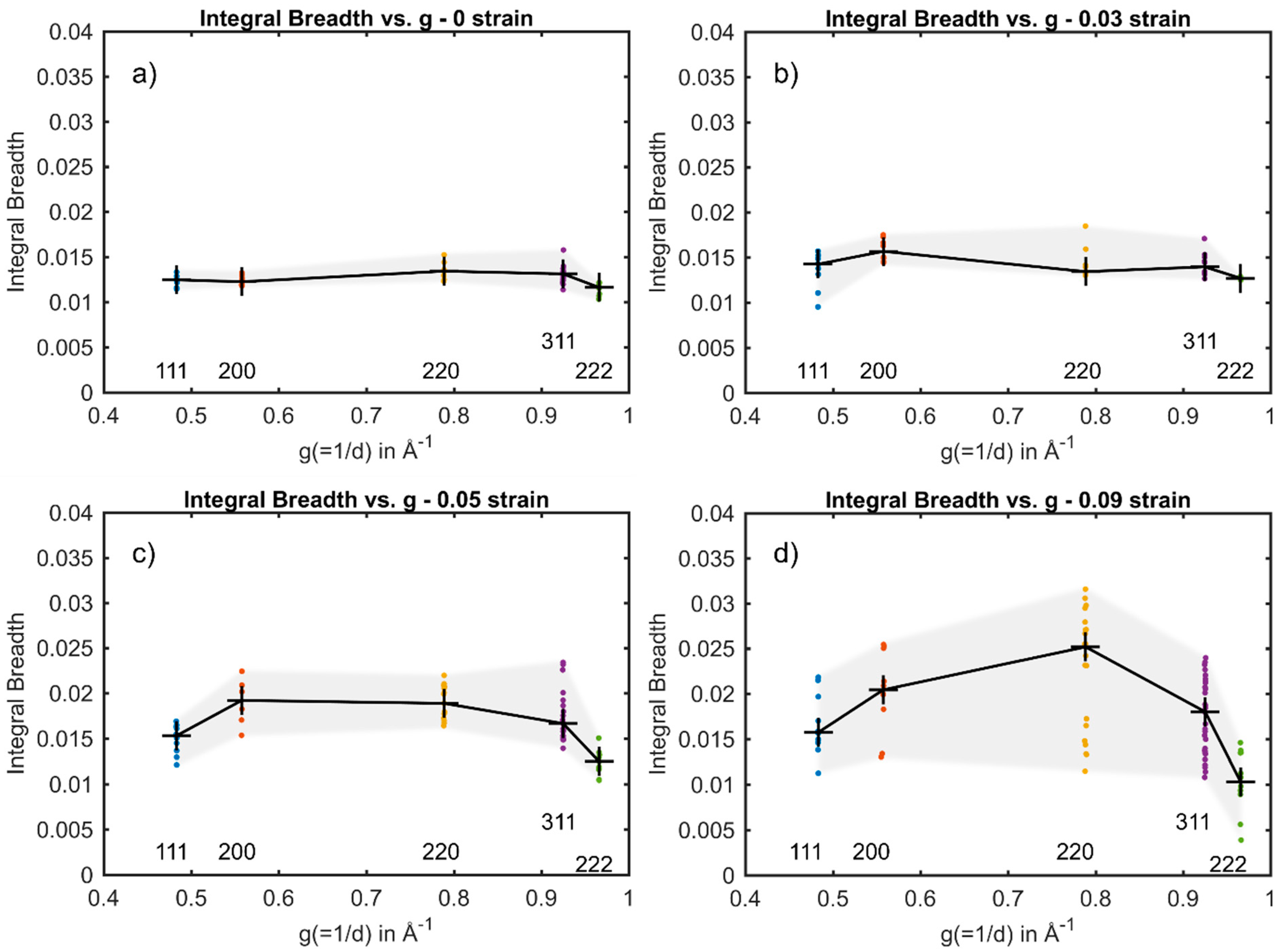
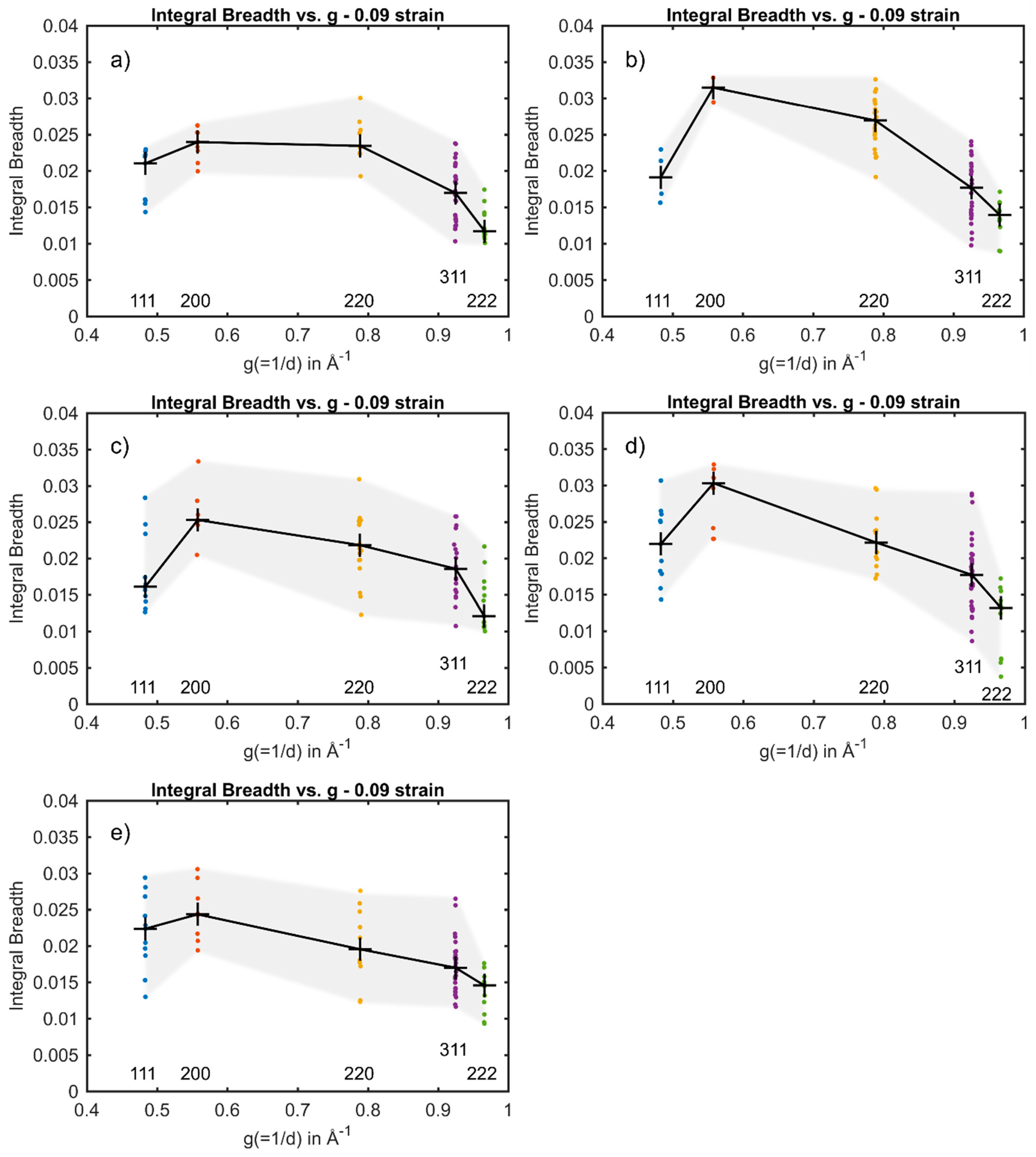
| Fe | Cr | Ni | C | N | Mo | W |
|---|---|---|---|---|---|---|
| bal. | 17.9 | 10.4 | 0.004 | 0.033 | 0.02 | 0.02 |
| Nom. Strain | Grain #29 | Grain #19 | Grain #26 | Grain #27 | Grain #12 | Grain #17 | |
|---|---|---|---|---|---|---|---|
| (×10−3) | 0 | N/A | - | - | - | - | - |
| 0.03 | 0.01 | - | - | - | - | - | |
| 0.05 | 0.05 | - | - | - | - | - | |
| 0.09 | 1.17 | 0.86 | 1.29 | 0.96 | 0.26 | 0.24 |
| u | v | w | h | k | l | ||
|---|---|---|---|---|---|---|---|
| −1 | 2 | −1 | 1 | 1 | 1 | 0 | −0.2357 |
| −1 | −1 | 2 | 1 | 1 | 1 | 0 | 0.4714 |
| 2 | −1 | −1 | 1 | 1 | 1 | 0 | −0.2357 |
| 2 | −1 | 1 | 1 | 1 | −1 | 0.1571 | 0.2357 |
| −1 | −1 | −2 | 1 | 1 | −1 | −0.3143 | −0.4714 |
| 1 | −2 | −1 | 1 | 1 | −1 | −0.1571 | −0.2357 |
| 1 | 2 | −1 | −1 | 1 | 1 | 0.1571 | −0.2357 |
| −2 | −1 | −1 | −1 | 1 | 1 | −0.3143 | −0.2357 |
| −1 | 1 | −2 | −1 | 1 | 1 | −0.1571 | −0.4714 |
| −1 | 1 | 2 | 1 | −1 | 1 | 0.1571 | 0.4714 |
| −1 | −2 | −1 | 1 | −1 | 1 | −0.3143 | −0.2357 |
| −2 | −1 | 1 | 1 | −1 | 1 | −0.1571 | 0.2357 |
Publisher’s Note: MDPI stays neutral with regard to jurisdictional claims in published maps and institutional affiliations. |
© 2021 by the authors. Licensee MDPI, Basel, Switzerland. This article is an open access article distributed under the terms and conditions of the Creative Commons Attribution (CC BY) license (https://creativecommons.org/licenses/by/4.0/).
Share and Cite
Neding, B.; Pagan, D.C.; Hektor, J.; Hedström, P. Formation of Dislocations and Stacking Faults in Embedded Individual Grains during In Situ Tensile Loading of an Austenitic Stainless Steel. Materials 2021, 14, 5919. https://doi.org/10.3390/ma14205919
Neding B, Pagan DC, Hektor J, Hedström P. Formation of Dislocations and Stacking Faults in Embedded Individual Grains during In Situ Tensile Loading of an Austenitic Stainless Steel. Materials. 2021; 14(20):5919. https://doi.org/10.3390/ma14205919
Chicago/Turabian StyleNeding, Benjamin, Darren C. Pagan, Johan Hektor, and Peter Hedström. 2021. "Formation of Dislocations and Stacking Faults in Embedded Individual Grains during In Situ Tensile Loading of an Austenitic Stainless Steel" Materials 14, no. 20: 5919. https://doi.org/10.3390/ma14205919
APA StyleNeding, B., Pagan, D. C., Hektor, J., & Hedström, P. (2021). Formation of Dislocations and Stacking Faults in Embedded Individual Grains during In Situ Tensile Loading of an Austenitic Stainless Steel. Materials, 14(20), 5919. https://doi.org/10.3390/ma14205919







